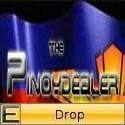by. Mike Snaden
The purpose of this article is to offer some explanation for some of the current misconceptions about water parameters pertaining to the term General Hardness or GH. It is unfortunate that a lot of UK koi hobbyists tend to take general aquaculture knowledge, and apply it directly to Nishikigoi. In so much as what is good for intensive aquaculture rearing techniques for food
fishes are also good for Nishikigoi pond management.
The two aquatic cultures have entirely different objectives involved, in what they set out to
achieve for the end result. Japanese breeders and universities are constantly striving to perfect production, growth, and health aspects of Koi. It is accepted that the Japanese are true masters and have made important discoveries that link good koi health, excellent growth and superior
Hi development to many aspects of koi keeping, non more so than the subject of Water
Hardness. The hobby would benefit greatly from attempting to learn from the Japanese professional Nishikigoi industry.
It's all too common to hear some hobbyists say, Mains water in certain areas is too soft, and
should be hardened. It's understandable that Carbonate Hardness (KH) should be elevated,
but the same cannot be said for General Hardness. So the focus of this short article is to offer some explanation as to why this need not be the case in so many instances, and that indicators fromJapan suggest that Soft water should be nurtured and taken advantage of, not necessarily hardened! It is generally accepted in Japan by the Koi industry / breeders, that Koi growth is enhanced in soft water. Hi will become thicker, the shine of the skin (Tsuya) will improve,
and last but not least, the health of the koi will be stimulated and greatly enhanced, hence less problems. But in a general sense the koi hobby tends to believe that Koi are put into Japanese mud ponds because of the high mineral content and low stocking levels will make the Koi potentially grow larger at a faster rate than would otherwise be the case. Whilst there is an element of truth in this statement, it does not show the full picture, and can be interpreted
as a misunderstanding. The fact is many of Niigata's mud ponds have soil that is so dead from
lack of minerals, that only rice (or Koi) can be grown there. However, mud ponds do offer
benefits such as live insects, and plankton
KH Carbonate Hardness or Alkalinity.
Carbonate hardness is essential for the buffering effect it has on the pH of water in a closed
circuit koi pond. If a recorded pH of a given volume of water is 8 and an amount of acid is
added, it is commonly expected that the pH value should drop by the corresponding amount of acid added, if there were little or no Kh value to the water, this would be the case, but the
purpose of KH is to act as a buffer so rather than the acid added to the pond directly
influencing the Ph value, the acid is spent on the carbonate ions in the KH value and only
when the carbonate reserves of the kh value are used up will the acid directly influence
and lower the ph. Hence, if the KH value falls too low, causing the pond water pH to be
influenced too easily by everyday occurrences such as fish respiration, fish urine, waste by-products from filtration system bacteria, plants life and even acid rain, in short just about everything that is considered normal in a pond environment that is capable of introducing
an acid base.
So by these examples it is easy to see why KH is so important. If a pond has a low KH, and
regular pond maintenance isn't carried out, the water will lose it's buffering capability, and
the pH will fall. At first this isn't a problem, as Koi are best suited to a pH of 7.0. But, if left unattended, the pH will fall to dangerous levels, and quickly crash the system. Resulting
in acidic water, and a pond full of either very unhappy or dead Koi, as well as a dead filter. Example: A pond in an area where the water has a typically low KH value This need not be a problem if the system falls into the following criteria, I.E. the pH runs at a steady 7.0, and
pond maintenance is done religiously, perhaps at twice-weekly intervals. The pond is not overstocked; feeding is done in constant measured amounts. There is a good working
knowledge and you understand the pond system and how it functions, plus the checking of
all water parameters are done at regular intervals, leave nothing to chance. But, if non of the
afore mentioned criteria are present it would be the authors advice to keep the pond water
KH well up and therefore well buffered, or disaster will strike! A good KH level should be somewhere in the region of 2 to 6dH. There is no point in running a higher level than 6,
as this will often result in a rise of the pH.
The Japanese consider a pH of between 6.8 and 7.4 to be ideal.
GH. General Hardness.
This is a measure of the amount of dissolved solids (mineral content), E.G. calcium, iron, aluminium, manganese, magnesium, chlorides, etc. GH has nothing directly to do with the KH buffering effects of water, also a GH measurement is no indication of the KH value as the two
are totally separate independent readings. And the only thing they share in common is the
term Hardness in the title name.
For Japanese Nishikigoi professionals, the ultimate goal is to achieve low GH values.
GH can be measured as ppm or dH, (German Degrees Hardness) Many things can effect Water hardness. A typical tap water reading in the Bristol area is around 14dH (250ppm, or parts per million).
In Japan this would be considered high! However many more things can effect and raise the
GH reading of a typical koi pond. Stocking levels, feeding levels, and chemicals will raise
hardness.
This is one of the primary reasons that Koi are grown-on in mud ponds. Water in a typical Japanese Mud pond, is generally between 35 and 85 ppm TDS. The stocking rates employed
with most mud ponds are kept low so that the daily feeding doesn't raise the water hardness.
It is thought by many, the main reason koi kept in Japanese mud ponds grow very quickly. Concrete Koi ponds in Japan are often overstocked, and the water is more likely to be in the region of 150 ppm TDS. This is the one of the main reasons many Japanese hobbyists put
their best Koi back into mud ponds each year, they can then grow in soft water, as opposed
to having their growth stunted with the harder water of a conventional Koi pond, Plankton and micro organisms are another reason. TDS. Total Dissolved Solids.
A TDS reading basically represents a combination of KH, GH, and any other dissolved solids.
The readings below have been taken using a Japanese TDS meter. This meter is sold in Japan
as a 'Water quality instrument'. From the TDS reading given below, we can obviously assume
that a TDS reading of lets say 80ppm, that the KH might be for arguements sake 2dH (36ppm), and hence the GH can therefore be a maximum of 2.45dH (44ppm).
This is just an example to help you understand that in a given TDS reading, a GH and KH in
total when combined, can't exceed the TDS reading, except when allowing for the innacuracy of the test.
The following are pond water statistics compiled over the past three years.
























